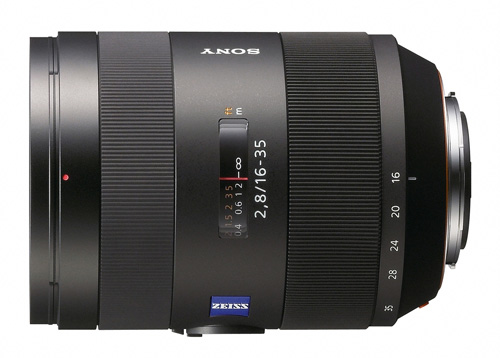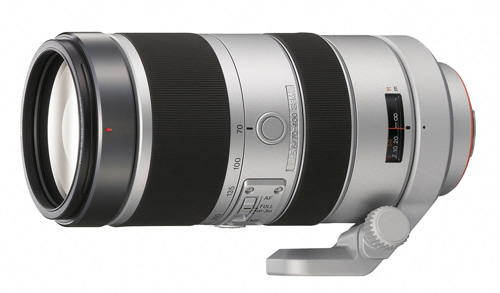Sony A900 Full-Frame: Hands-On Preview
by Wesley Fink on September 12, 2008 12:00 AM EST- Posted in
- Digital Camera
New Zeiss 16-35mm f/2.8 and 70-400mm f/4-5.6 G Lenses
SAN DIEGO, Sept. 9, 2008 - Sony is expanding its number of high performance Carl Zeiss and G Series lenses with the addition of the new SAL1635ZA and SAL70400G models.
Vario Sonnar T* 16-35mm f/2.8 ZA Carl Zeiss Series Lens

The SAL1635ZA model is a super wide-angle 16-35mm f/2.8 constant aperture zoom lens, well suited for landscape, snapshot, and indoor photography. It is constructed of 17 lens elements in 13 groups, including an extra-low dispersion (ED) for exceptional clarity and center-to-edge resolution and a super ED glass element for much stronger correction of chromatic aberration or discoloration. It also features three aspherical lens elements that provide greater brightness from center to the edge of the image field. Its Carl Zeiss T* (T star) coating technology provides higher light transmission, and minimizes flare to produce images of luminous clarity, color and sharpness.
The SAL1635ZA lens offers the utmost flexibility in challenging lighting conditions due to its wide f/2.8 constant aperture. Combined with Sony's in-camera SteadyShot Inside image stabilization system, this lens is the only large aperture, full-frame capable, wide-angle zoom lens with the benefit of stabilization in the industry. Smooth, fast, and precise focusing is delivered by Sony's Super Sonic wave Motor (SSM) autofocus drive system. It utilizes a solid-state focus drive motor to provide silent, high-speed response, powerful torque, and fine rotational control - critically important for large wide-aperture lenses.
70-400mm f/4-5.6 G Series Lens

The SAL70400G lens is a 5.7x super telephoto zoom lens and the latest addition to Sony's G-series line of premium lenses. Designed to deliver extremely sharp descriptive performance across its wide focal length range, it is ideally suited for sports, action, and wildlife photography. Constructed of 18 elements in 12 groups, it includes two extra-low dispersion glass lenses for high contrast, sharp details, and exceptional center-to-edge resolution with minimal chromatic aberration. A circular aperture with nine diaphragm blades is utilized to achieve natural, aesthetically pleasing de-focusing effects.
With a minimum focus distance of 1.5m and maximum magnification of 0.27x, the lens delivers best-in-class performance. Like the SAL1635ZA lens, focus drive is provided by its SSM system, which offers the speed and rotational precision often required for telephoto shooting. Additionally, the lens has an internal focusing system for faster autofocusing.
A focus-mode/range switch and three focus-hold buttons have been added to the lens barrel for enhanced operability. For both models, when attached to the flagship α900 camera body, the AF hold buttons can be customized to activate the intelligent preview function.
Price and Availability
The Vario-Sonnar T* 16-35mm f/2.8 ZA and 70-400mm f/4-5.6 G lens will ship in January 2009 for about $1,800 and $1,500, respectively.










53 Comments
View All Comments
sprockkets - Saturday, September 13, 2008 - link
Flash that Makes L Brackets Obsolete - Fortunes have been made with L brackets for pro cameras that enable shooting flash vertical with the flash also rotated 90 degrees. When you see the new Sony HVL-F58AM flash, you'll wonder why Sony - or you, or anyone else - didn't think of it sooner. The flash head turns smoothly in a 90 degree arc as one of its movements - aligning the flash perfectly for portrait mode. Goodbye L bracket.Sorry, quote funtion wouldn't work. Why is this an issue? Flashes for the longest time do something really easy to bounce or flash vertically in portrait mode. It's called they rotate horizontally. The only advantage here I suppose is that the back display is now easier to read facing up. Am I missing something here?
Maxington - Monday, September 15, 2008 - link
I was wondering the same thing about the Sony flash, exactly what is so special about it?I can do ceiling bounce flash holding the camera in portrait with my Pentax 540 flash, and that's been out for years.
What is this Sony flash doing that has everyone so excited?
randomlinh - Sunday, September 14, 2008 - link
I was thinking the same... this moves the flash a little closer in line with the lens.. but l brackets still have one huge advantage... it RAISES the flash up, which can be quite beneficial in itself.Crafty Spiker - Saturday, September 13, 2008 - link
Regardless of the product - do you really want to "vote" for Sony?melgross - Friday, September 12, 2008 - link
It's interesting that both Canon's 5D, and Nikon's D700 cameras are considered to be, even by their manufacturers, advanced amateur or semi-pro bodies, but at the same price level, the Sony 900 is considered to be professional, ala the Canon 1Ds, 1D, and Nikon D3.Sorry, this camera isn't built like those pro bodies from Canon and Nikon.
While pro's certainly use the 5D, and D700, they also use the 40D and the D300.
So, are those now pro bodies as well?
Sensor size doesn't determine whether a body is pro, and really, neither does weather sealing.
The 1Ds 1D, and D3 are certainly the most rugged bodies on the market, nothing else approaches them in this.
chiew - Sunday, September 14, 2008 - link
Sony has no weather sealed lenses...I doubt pros who shoot in adverse conditions will want a Sony until it is proven.Wesley Fink - Saturday, September 13, 2008 - link
The Canon 5D and Nikon D700 have 95% wiewfinders. So do the D300 and 40D. The Nikon D3, Canon 1Ds MkIII, AND Sony A900 all have 100% viewfinders. That is certainly one measure of a Pro camera.In comparing the build quality of the A900 to my D3 I did not find the A900 lacking. Of course the test of time is what matters most in evaluating build quality and it will take a while to see if the build is as rugged as it appears.
I assumed the grip would be an Achilles heel since the other Pro models have a built-in grip. However, the A900 grip uses the same magnesium alloy shell and sealing used on the a900. Still, an integrated grip would certainly be better sealed almost by definition. Frankly I prefer a grip I can leave at home if I choose. The true Pro models that fit your criteria are all a pain to lug around in the field. That's why my D4 stays at home sometimes and the D700 goes with me.
In the end I have no doubt the Sony is as well constructed as the other cameras you judge as Pro. I do, however, have reservations about a shutter that is only rated for 100,000 actuations. That is very low for a camera to be considered Pro, and is much more typical of semi-Pro or Advanced prosumer models.
melgross - Wednesday, September 17, 2008 - link
Big deal. Over the years, the Nikon F series had a 100% viewfinder. That didn't prevent Canon from knocking it off it;s top spot, even though Canon didn't consider that to be important.In fact, for many years, a 100% viewfinder was considered to be a negative. When we shot transparencies, the mount covered the millimeter around the outside edge of the slide, making what you saw no more than about 96% of the total. Using a 100% viewfinder often caused the mount to hide the edge of what you saw anyway.
Nowadays, it;s true, that doesn't matter, but 2 to 5% of the viewfinders outside edges is of no real noticeable importance if its less than the full frame. The problem would be the other way around.
I think the shutter is far more important in telling us what this camera is intended for than whatever else we can see from the outside. Can't judge a camera by its shell. Even the 5D II now has a 150,000 cycle shutter.
Lord 666 - Saturday, September 13, 2008 - link
The D300 has a 100% viewfinder. However, at $3000 for the D700, they could have easily used the same from D3... but more than likely did not to protect sales of D3.http://www.nikonusa.com/Find-Your-Nikon/Product/Di...">http://www.nikonusa.com/Find-Your-Nikon/Product/Di...
Wesley Fink - Saturday, September 13, 2008 - link
You are correct, the D300 does have a 100% finder. Mea Culpa.